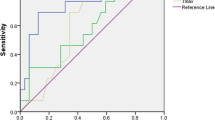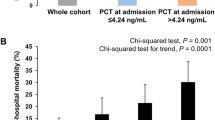Abstract
Background
Patients with extensive brain infarcts are at increased risk for stroke-associated respiratory tract infections (SARTI), which cause worse outcome. The benefit of general antibiotic prophylaxis is controversial. Early diagnosis of SARTI may improve patient selection for antimicrobial therapy. Procalcitonin (PCT) is widely recognized as serum marker for bacterial infections. Its diagnostic value with respect to SARTI has not been assessed systematically.
Methods
Serum PCT levels were analyzed in ischemic stroke patients (n = 50) at day 1 (d1) and day 4 (d4) after stroke onset. PCT test performance was assessed by receiver operator characteristics (ROC) curve analysis. Multivariable logistic regression analysis was applied to identify early predictors for SARTI.
Results
Higher d4 serum PCT levels were associated with SARTI; ROC curve analysis revealed an area under the curve (AUC) of 0.79 (95%-confidence interval (CI) 0.61–0.96). A 0.25-ng/ml cutoff resulted in a test sensitivity and specificity of 42 and 96%, respectively. Positive (LR+) and negative (LR−) likelihood ratios were 10.8 and 0.6, respectively. In predicting SARTI, multivariable logistic regression analysis controlling for infarct volume ruled out an independent explanatory effect of serum PCT. Greater infarct volume (odds ratio (OR) 1.06, 95%-CI 1.02–1.1) prevailed as independent SARTI-predictor.
Conclusions
In the absence of clinical signs, post-stroke screening for SARTI using serum PCT levels is not useful since test sensitivity is low. If the clinical suspicion for SARTI is strong, serum PCT-testing (>0.25 ng/ml) may improve diagnostic accuracy by improving specificity.


Similar content being viewed by others
Abbreviations
- AUC:
-
Area under the curve
- BAL:
-
Bronchoalveolar lavage
- CI:
-
Confidence interval
- CNS:
-
Central nervous system
- CRP:
-
C-reactive protein
- CT:
-
Computed tomography
- d1:
-
Day 1 post-stroke
- d4:
-
Day 4 post-stroke
- GCS:
-
Glasgow coma scale
- h:
-
Hours
- HLA-DR:
-
Human leukocyte antigen-DR
- IQR:
-
Interquartile range
- LR−:
-
Negative likelihood ratio
- LR+:
-
Positive likelihood ratio
- LRTI:
-
Lower respiratory tract infection
- ml:
-
Milliliter
- MRI:
-
Magnetic resonance imaging
- n:
-
Number
- n.s.:
-
Non-significant
- ng:
-
Nanogram
- NIHSSS:
-
National Institute of Health Stroke Scale Score
- nl:
-
Nanoliter
- OR:
-
Odds ratio
- PCT:
-
Procalcitonin
- ROC:
-
Receiver operator characteristics
- SAI:
-
Stroke-associated infection
- SARTI:
-
Stroke-associated respiratory tract infection
- SID:
-
Stroke-induced immune depression
- VAP:
-
Ventilator-associated pneumonia
- WBC:
-
White blood cell count
References
Chamorro A, Urra X, Planas AM. Infection after acute ischemic stroke: a manifestation of brain-induced immunodepression. Stroke (a journal of cerebral circulation). 2007;38:1097–103.
Dirnagl U, Klehmet J, Braun JS, Harms H, Meisel C, Ziemssen T, et al. Stroke-induced immunodepression: experimental evidence and clinical relevance. Stroke (a journal of cerebral circulation). 2007;38:770–3.
Emsley HC, Hopkins SJ. Acute ischaemic stroke and infection: recent and emerging concepts. Lancet Neurol. 2008;7:341–53.
Hug A, Dalpke A, Wieczorek N, Giese T, Lorenz A, Auffarth G, et al. Infarct volume is a major determiner of post-stroke immune cell function and susceptibility to infection. Stroke (a journal of cerebral circulation). 2009;40:3226–32.
Aslanyan S, Weir CJ, Diener HC, Kaste M, Lees KR. Pneumonia and urinary tract infection after acute ischaemic stroke: a tertiary analysis of the gain international trial. Eur J Neurol. 2004;11:49–53.
Katzan IL, Cebul RD, Husak SH, Dawson NV, Baker DW. The effect of pneumonia on mortality among patients hospitalized for acute stroke. Neurology. 2003;60:620–5.
Vermeij FH, Scholte op Reimer WJ, de Man P, van Oostenbrugge RJ, Franke CL, de Jong G, de Kort PL, Dippel DW. Stroke-associated infection is an independent risk factor for poor outcome after acute ischemic stroke: data from the Netherlands stroke survey. Cerebrovasc Dis (Basel, Switzerland). 2009;27:465–71.
Chamorro A, Horcajada JP, Obach V, Vargas M, Revilla M, Torres F, et al. The early systemic prophylaxis of infection after stroke study: a randomized clinical trial. Stroke (a journal of cerebral circulation). 2005;36:1495–500.
Harms H, Prass K, Meisel C, Klehmet J, Rogge W, Drenckhahn C, et al. Preventive antibacterial therapy in acute ischemic stroke: a randomized controlled trial. PLoS ONE. 2008;3:2158.
Schwarz S, Al-Shajlawi F, Sick C, Meairs S, Hennerici MG. Effects of prophylactic antibiotic therapy with mezlocillin plus sulbactam on the incidence and height of fever after severe acute ischemic stroke: the Mannheim infection in stroke study (miss). Stroke (a journal of cerebral circulation). 2008;39:1220–7.
European Stroke Organisation (ESO) Executive Committee; ESO Writing Committee. Guidelines for management of ischaemic stroke and transient ischaemic attack 2008. Cerebrovasc Dis. 2008;25:457–507.
Adams HP Jr, del Zoppo G, Alberts MJ, Bhatt DL, Brass L, Furlan A, et al. Guidelines for the early management of adults with ischemic stroke: a guideline from the american heart association/american stroke association stroke council, clinical cardiology council, cardiovascular radiology and intervention council, and the atherosclerotic peripheral vascular disease and quality of care outcomes in research interdisciplinary working groups: the american academy of neurology affirms the value of this guideline as an educational tool for neurologists. Stroke. 2007;38:1655–711.
Emsley HC, Tyrrell PJ. Inflammation and infection in clinical stroke. J Cereb Blood Flow Metab. 2002;22:1399–419.
Hilker R, Poetter C, Findeisen N, Sobesky J, Jacobs A, Neveling M, et al. Nosocomial pneumonia after acute stroke: implications for neurological intensive care medicine. Stroke (a journal of cerebral circulation). 2003;34:975–81.
Uzzan B, Cohen R, Nicolas P, Cucherat M, Perret GY. Procalcitonin as a diagnostic test for sepsis in critically ill adults and after surgery or trauma: a systematic review and meta-analysis. Crit Care Med. 2006;34:1996–2003.
Stolz D, Stulz A, Muller B, Gratwohl A, Tamm M. Bal neutrophils, serum procalcitonin, and c-reactive protein to predict bacterial infection in the immunocompromised host. Chest. 2007;132:504–14.
Christ-Crain M, Jaccard-Stolz D, Bingisser R, Gencay MM, Huber PR, Tamm M, et al. Effect of procalcitonin-guided treatment on antibiotic use and outcome in lower respiratory tract infections: cluster-randomised, single-blinded intervention trial. Lancet. 2004;363:600–7.
Duflo F, Debon R, Monneret G, Bienvenu J, Chassard D, Allaouchiche B. Alveolar and serum procalcitonin: diagnostic and prognostic value in ventilator-associated pneumonia. Anesthesiology. 2002;96:74–9.
Luyt CE, Guerin V, Combes A, Trouillet JL, Ayed SB, Bernard M, et al. Procalcitonin kinetics as a prognostic marker of ventilator-associated pneumonia. Am J Respir Crit Care Med. 2005;171:48–53.
Pelosi P, Barassi A, Severgnini P, Gomiero B, Finazzi S, Merlini G, et al. Prognostic role of clinical and laboratory criteria to identify early ventilator-associated pneumonia in brain injury. Chest. 2008;134:101–8.
Miyakis S, Georgakopoulos P, Kiagia M, Papadopoulou O, Pefanis A, Gonis A, et al. Serial serum procalcitonin changes in the prognosis of acute stroke. Clinica Chimica Acta (international journal of clinical chemistry). 2004;350:237–9.
Adams HP Jr, Bendixen BH, Kappelle LJ, Biller J, Love BB, Gordon DL, et al. Classification of subtype of acute ischemic stroke. Definitions for use in a multicenter clinical trial. Toast. Trial of org 10172 in acute stroke treatment. Stroke (a journal of cerebral circulation). 1993;24:35–41.
Meisel C, Schwab JM, Prass K, Meisel A, Dirnagl U. Central nervous system injury-induced immune deficiency syndrome. Nat Rev Neurosci. 2005;6:775–86.
Stover DE, Zaman MB, Hajdu SI, Lange M, Gold J, Armstrong D. Bronchoalveolar lavage in the diagnosis of diffuse pulmonary infiltrates in the immunosuppressed host. Ann Intern Med. 1984;101:1–7.
Kahn FW, Jones JM. Diagnosing bacterial respiratory infection by bronchoalveolar lavage. J Infect Dis. 1987;155:862–9.
Xaubet A, Torres A, Marco F, Puig-De la Bellacasa J, Faus R, Agusti-Vidal A. Pulmonary infiltrates in immunocompromised patients. Diagnostic value of telescoping plugged catheter and bronchoalveolar lavage. Chest. 1989;95:130–5.
Joos L, Chhajed PN, Wallner J, Battegay M, Steiger J, Gratwohl A, et al. Pulmonary infections diagnosed by bal: a 12-year experience in 1066 immunocompromised patients. Respir Med. 2007;101:93–7.
Langhorne P, Stott DJ, Robertson L, MacDonald J, Jones L, McAlpine C, et al. Medical complications after stroke: a multicenter study. Stroke (a journal of cerebral circulation). 2000;31:1223–9.
Davenport RJ, Dennis MS, Wellwood I, Warlow CP. Complications after acute stroke. Stroke (a journal of cerebral circulation). 1996;27:415–20.
Johnston KC, Li JY, Lyden PD, Hanson SK, Feasby TE, Adams RJ, et al. Medical and neurological complications of ischemic stroke: experience from the ranttas trial. Ranttas investigators. Stroke (a journal of cerebral circulation). 1998;29:447–53.
Fassbender K, Dempfle CE, Mielke O, Rossol S, Schneider S, Dollman M, et al. Proinflammatory cytokines: indicators of infection in high-risk patients. J Lab Clin Med. 1997;130:535–9.
Grau AJ, Buggle F, Schnitzler P, Spiel M, Lichy C, Hacke W. Fever and infection early after ischemic stroke. J Neurol Sci. 1999;171:115–20.
Weimar C, Roth MP, Zillessen G, Glahn J, Wimmer ML, Busse O, et al. Complications following acute ischemic stroke. Eur Neurol. 2002;48:133–40.
Hamidon BB, Raymond AA, Norlinah MI, Jefferelli SB. The predictors of early infection after an acute ischaemic stroke. Singapore Med J. 2003;44:344–6.
Pittock SJ, Meldrum D, Hardiman O, Thornton J, Brennan P, Moroney JT. The oxfordshire community stroke project classification: correlation with imaging, associated complications, and prediction of outcome in acute ischemic stroke. J Stroke Cerebrovasc Dis. 2003;12:1–7.
Ovbiagele B, Hills NK, Saver JL, Johnston SC. Frequency and determinants of pneumonia and urinary tract infection during stroke hospitalization. J Stroke Cerebrovasc Dis. 2006;15:209–13.
Kwan J, Hand P. Infection after acute stroke is associated with poor short-term outcome. Acta Neurol Scand. 2007;115:331–8.
Haeusler KG, Schmidt WU, Fohring F, Meisel C, Helms T, Jungehulsing GJ, et al. Cellular immunodepression preceding infectious complications after acute ischemic stroke in humans. Cerebrovasc Dis (Basel, Switzerland). 2008;25:50–8.
Vogelgesang A, Grunwald U, Langner S, Jack R, Broker BM, Kessler C, et al. Analysis of lymphocyte subsets in patients with stroke and their influence on infection after stroke. Stroke (a journal of cerebral circulation). 2008;39:237–41.
Urra X, Cervera A, Villamor N, Planas AM, Chamorro A. Harms and benefits of lymphocyte subpopulations in patients with acute stroke. Neuroscience. 2009;158(3):1174–83.
Acknowledgments
This study was supported by a grant from the Else Kröner Fresenius Stiftung to R.V. R.V. is supported by an Else Kröner Memorial scholarship.
Authorship responsibility and contributions
Andreas Hug conceived and designed the research, enrolled patients, acquired/analyzed clinical data/blood specimens, performed statistical analysis and drafted the manuscript.
Bettina Mürle performed brain MRIs/volumetric analysis of brain infarcts and made critical revisions of the manuscript for important intellectual content.
Alexander Dalpke analyzed clinical data/blood specimens and made critical revisions of the manuscript for important intellectual content.
Markus Zorn analyzed blood specimens and made critical revisions of the manuscript for important intellectual content.
Arthur Liesz analyzed clinical data and made critical revisions of the manuscript for important intellectual content.
Roland Veltkamp designed the research, handled funding and supervision and made critical revisions of the manuscript for important intellectual content.
Author information
Authors and Affiliations
Corresponding author
Additional information
The study was performed at the University Hospital Heidelberg, INF 400, 69120 Heidelberg, Germany.
Rights and permissions
About this article
Cite this article
Hug, A., Mürle, B., Dalpke, A. et al. Usefulness of Serum Procalcitonin Levels for the Early Diagnosis of Stroke-Associated Respiratory Tract Infections. Neurocrit Care 14, 416–422 (2011). https://doi.org/10.1007/s12028-009-9325-6
Published:
Issue Date:
DOI: https://doi.org/10.1007/s12028-009-9325-6




